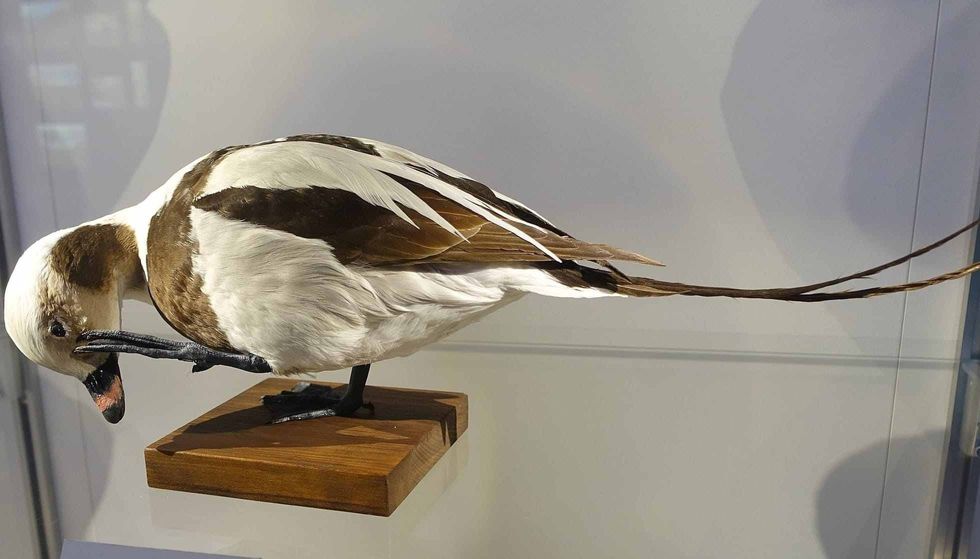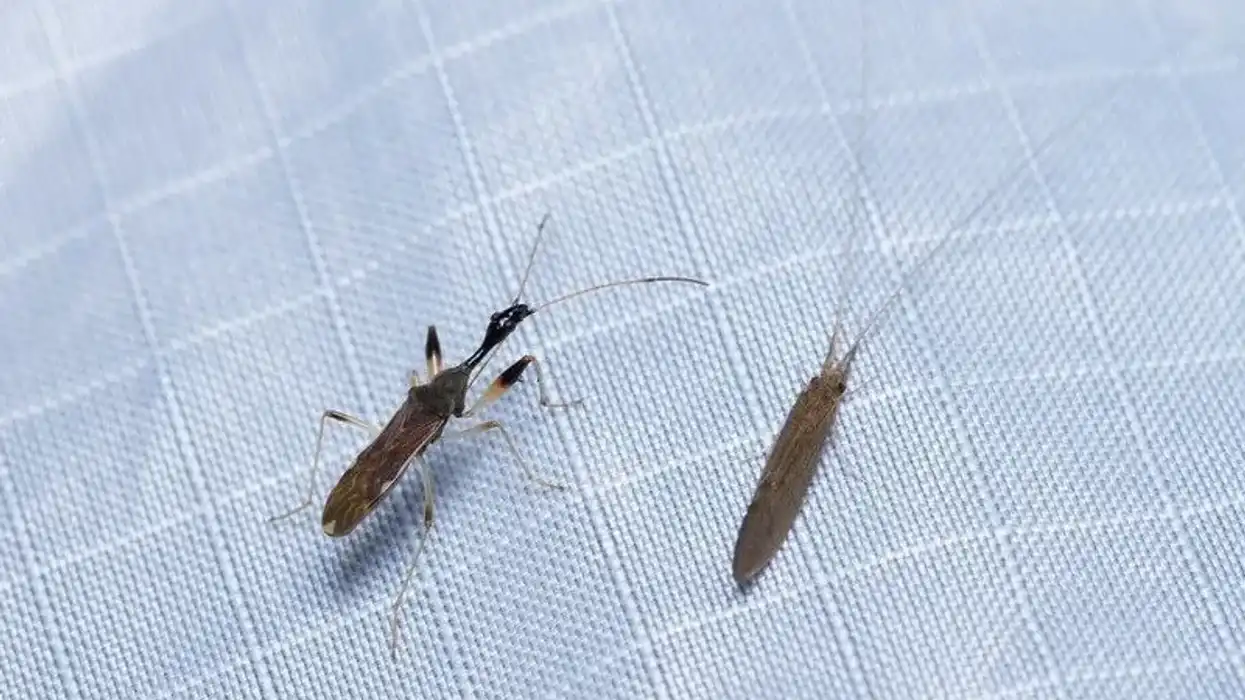The long-tailed duck (Clangula hyemalis) is a medium-sized species of sea duck abundant in the cold waters of the circumpolar region. These birds have a limited geographical range and are frequently found breeding along the Arctic coast of North America, Russia, Iceland, and Norway.
They form large flocks and spend most of their time in the sea. In the winter, these North American birds are found in the cold waters of the north such as the Great Lakes, the Hudson Bay, and the Bering Sea.
Predominantly white with dark wings and brownish-black markings on the body, male members of this sea duck species have characteristic long, dark, and slender tail feathers that give the bird its name. It is also the male's typical breeding plumage. In contrast, females have brown plumage and are starkly different from males in terms of size and plumage coloration.
Want to learn more about these birds of the north? Then carry on reading for more interesting and fun facts about these sea ducks! You may also like to read facts about birds such as ducks and Muscovy ducks.
Long-Tailed Duck Interesting Facts
What type of animal is a long-tailed duck?
The long-tailed duck is a species of sea duck belonging to the family Anatidae.
What class of animal does a long-tailed duck belong to?
Long-tailed ducks belong to the class Aves which includes all birds.
How many long-tailed ducks are there in the world?
According to Wetlands International, in 2017 the global population of long-tailed ducks was estimated to be around 3,200,000 to 3,750,000 individuals.
Where does a long-tailed duck live?
Long-tailed ducks live in a wide range of habitats that include pools and marshes in the tundra, sea coasts, and large mountain lakes. They are also found in areas that offer both terrestrial and aquatic habitats such as Arctic marshy grass tundra, coastal inlets, promontories, and offshore islands.
What is a long-tailed duck's habitat?
Even though the habitat of this species of ducks is quite diverse, their geographical range is concentrated in the cold waters of the north. However, compared to other aquatic fowl, their range is quite large and spread throughout most of the North American coasts.
The winter is spent in large lakes or the open ocean and in the summer, they migrate to tundra lakes and pools.
Their breeding zone is along the Arctic coasts of the United States of America, Alaska, northern Canada, Russia, Norway, Iceland, Greenland, and northern Europe, as well as the large mountain lakes and seacoasts in the North Atlantic.
Their nest which is made with plant material can be found on the ground and near water. Winter is the time for migration of these birds when they are mostly seen in the Great Lakes, along the North American west and east coast, coastal Asia, and northern Europe.
The Baltic Sea and the Black Sea are major wintering areas for long-tailed ducks.
Who do long-tailed ducks live with?
Long-tailed ducks are gregarious birds that form large flocks during the migration season and in winter. Such flocks spend most of the winter in the northern waters.
How long does a long-tailed duck live?
Long-tailed ducks live for an average of 15.3 years in the wild.
How do they reproduce?
Long-tailed ducks engage in an elaborate courtship display before mating, during which male birds approach potential females with an outwardly held bill and upright tail. As the male nears a prospective female, the former bows its head and emits typical mating calls.
The breeding season spans from early May to July but variations may occur depending on the availability of mates and the location of the breeding ground. Breeding season occurs once a year.
Post-breeding, a female duck lays about six to eight eggs which are incubated for 24 to 30 days. Males defend the nest when the eggs are laid.
After the eggs hatch, the young ducklings that are born remain in the nest, and their first flight occurs only when they are 35 to 40 days old. The mother duck teaches the young ducklings how to dive into the water for food.
What is their conservation status?
According to the International Union for Conservation of Nature (IUCN) Red List of Threatened Species, the conservation status of the long-tailed duck species is Vulnerable.
Long-Tailed Duck Fun Facts
What do long-tailed ducks look like?
Regardless of the plumage coloration, the short and pointed dark wings are evident in both male and female ducks. Long-tailed ducks undergo a seasonal molting process, during which the body plumage shifts between different colorations.
The breeding plumage of a male is characterized by long and black tail feathers, a white belly and rump, and a black breast. The shoulders are brown, there are white patches around the eye, and the back and head are black.
In the winter season, their back and head become white, and there are gray patches on their cheeks. Males have a dark bill with a pinkish band around the middle.
In the spring season, female birds are mostly gray with white areas around the eyes, on the neck, and the rump. In winter, a female bird has a white face, neck, and throat with a brown crown and ear patches.
A broad, brown breast band is also visible. The wings, backs, and tails are also brown, but the belly region is white. The bills are a shade of dark bluish-gray.

How cute are they?
The long-tailed duck is a neat bird that looks quite adorable due to its cheek patch.
How do they communicate?
The long-tailed duck species is particularly vocal with calls that range from growls and clucks to squawks and yodels. Mating calls from males consist of a succession of four or five calls, and the females respond with single calls and growls.
In addition, competing males use physical gestures such as tilting their heads and spreading their wings during confrontations. A female bird uses specific calls while supervising the diving of her young ducklings.
How big is a long-tailed duck?
The standard length of a long-tailed duck is 17.5-23.5 in (44.4-60 cm) with a wingspan of around 28 in (71 cm). It is larger than a Stellar's eider, another species of sea duck.
How fast can a long-tailed duck fly?
Being a waterfowl, a long-tailed duck should have an average flying speed of 50 mph (80.5 kph).
How much does a long-tailed duck weigh?
The standard weight of a long-tailed duck is around 1.63 lb (740 g).
What are the male and female names of the species?
A female bird is called a duck or hen, and a male is known as a drake.
What would you call a baby long-tailed duck?
A baby long-tailed duck is called a duckling.
What do they eat?
The food of long-tailed ducks comprises mollusks, crustaceans, fish eggs, small fish, freshwater insects, and other invertebrates of the sea and ocean. Besides a diet rich in crustaceans, their food also consists of plant material such as fruits, seeds, grasses, and algae.
Are they dangerous?
Long-tailed ducks are not known to pose any serious threat to humans.
Would they make a good pet?
The harmless nature of long-tailed ducks makes them good domestic birds.
Did you know...
In North America, a long-tailed duck is also known as an oldsquaw.
Known predators of these ducks include red foxes, Arctic foxes, and birds like glaucous gulls and mew gulls.
Long-tailed ducks build bowl-shaped nests made of plant material and a lining of down that a female bird plucks from her own body.
Unlike other diving ducks, long-tailed ducks use their wings for diving which allows them to go much deeper.
Adult male long-tailed ducks begin molting during the incubation period of the eggs which happens between the later part of June to early September.
How deep can a long-tailed duck dive?
A long-tailed duck is capable of diving to depths of up to 200 feet (61 m). The Audubon Society Guide to North American Birds states that these ducks can dive as deep as 480 ft (146 m).
How long can a duck hold its breath underwater?
While a dive usually lasts for about 10 to 30 seconds, diving ducks can stay underwater for a minute or even more!
Here at Kidadl, we have carefully created lots of interesting family-friendly animal facts for everyone to discover! Learn more about some other birds, including the Asian palm civet or blue lacy dog.
You can even occupy yourself at home by drawing one on our long-tailed duck coloring pages.










